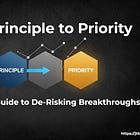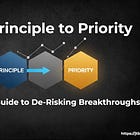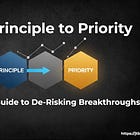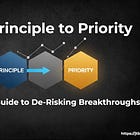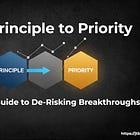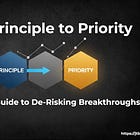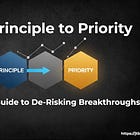From Principle to Priority: Chapter 5
From Job to Journey: Creating the Job Map
This 10-article series is designed to disrupt common thinking about innovation. It provides a new framework to help you tear down old methods and invest more efficiently in breakthrough ideas. Please share!
Part 3
STAGE 2 - THE OPTION TO VALIDATE (Opportunity Sizing)
We have successfully completed the first stage of our process. We have paid the premium for our Option to Explore and, in return, have acquired a high-resolution, qualitative hypothesis. We’ve used First Principles to identify the real problem (a new, unmanaged financial liability) and the Jobs-to-be-Done framework to pinpoint the right Job Executor (the CFO) and their complex motivations (functional, social, and emotional).
We have a powerful insight. But we do not have a business.
We are now at the funding gate for our second, larger investment: the Option to Validate. The business case question for this stage is no longer qualitative; it is quantitative. We must now answer: “Is this problem big enough to matter? Can we quantify the struggle, identify a critically underserved segment of the market, and prove this is an opportunity worth a major investment?”
Our CFO hypothesis is a strong one, but it is still just a hypothesis. We believe they are struggling, but where? How often? And how much?
Our impulse might be to commission a broad market-sizing report from an analyst firm to find the Total Addressable Market (TAM) for “carbon accounting software.” This is a classic mistake. A top-down TAM is a vanity metric; it tells us nothing about the actual, bottom-up struggle of our specific Job Executor. It sizes the existing, broken solution, not the new opportunity we’ve uncovered.
To find the opportunity, we must first create the instrument that allows us to measure it. We cannot survey the CFO about their “pain points” with “mitigating liabilities”; the question is too abstract. We must deconstruct their single, core job—”Mitigating quantified environmental liabilities in a verifiable and auditable manner”—into a detailed, chronological, and measurable process.
This tool is the Job Map.
A Job Map is not a “customer journey map.” A customer journey map is solution-aware; it details a customer’s interactions with a company’s existing touchpoints (website, sales, support). It is a map of the company’s process.
A Job Map is solution-agnostic. It is a map of the customer’s process. It details the universal, logical, and chronological steps the Job Executor must go through to get their core job done, regardless of what solution (if any) they are using today.
The structure of a Job Map is stable and follows a universal logic, typically broken into several key phases:
Define: Planning and scoping the entire job.
Locate: Gathering the necessary inputs and information.
Prepare: Organizing and preparing those inputs for use.
Confirm: Ensuring all of the inputs are ready for execution.
Execute (Core): Performing the central function of the job.
Monitor: Verifying that the execution is successful.
Resolve: Fixing problems or errors that arise.
Modify: Making adjustments and corrections.
Conclude: Finishing the job.
Our task is to apply this framework to our Job Executor. What are the logical, sequential steps a CFO (or their delegates, for whom they are ultimately responsible) must take to execute the job of “Mitigating quantified environmental liabilities in a verifiable and auditable manner”?
Let’s build that map.
The Job Map: Mitigating Quantified Environmental Liabilities
DEFINE: The ability to determine the specific scope of the liability (e.g., which geographies, business units, and emission types are included) based on evolving regulatory and investor requirements.
LOCATE: The ability to gather all necessary operational and financial data (e.t., energy consumption, supply chain manifests, procurement records) from dozens of disparate, non-standardized, and often offline systems.
PREPARE: The ability to aggregate and standardize this fragmented data into a single, auditable format suitable for quantification.
CONFIRM: The ability to perform a final validation of the prepared dataset to ensure completeness, accuracy, and readiness for quantification before committing to the calculation.
EXECUTE (Quantify): The ability to calculate the final liability (the total “tonne” count) using approved methodologies and emission factors.
EXECUTE (Neutralize): The ability to source and vet verifiable, high-quality offset projects or carbon removal credits to neutralize the quantified liability.
MONITOR: The ability to verify the “retirement” of the purchased offsets to ensure they are not re-sold and to confirm the liability is legally and financially extinguished.
RESOLVE: The ability to investigate and remedy any discrepancies, audit flags, or verification failures identified during the monitoring step.
MODIFY: The ability to update the calculations and neutralization strategy in real-time as new data becomes available or regulations change mid-cycle.
CONCLUDE: The ability to generate the final, auditable reports for disclosure to the board, investors, and regulators, providing a clear chain of custody from the initial data to the final retired offset.
This Job Map is a game-changer. We have transformed a single, abstract job statement into a discrete, ten-step process. We have pinpointed the exact chronological activities that constitute the CFO’s struggle.
This map is the foundational structure for our entire quantitative effort. It is the scaffold upon which we will build our quantitative survey. We will not ask, “How hard is your job?” We will ask, “Please rate the difficulty of determining the scope of the liability (Step 1),” “Please rate the difficulty of gathering the necessary data (Step 2),” and so on.
By creating this map, we have defined the “where.” We have a comprehensive list of every potential point of friction, failure, and frustration.
But to size the opportunity, we need one more layer of detail. For each step in this map, we need to know what “success” looks like. We need to define the metrics the CFO uses to judge a “good” or “bad” outcome at each step. These are their Customer Success Statements, and they are the key to unlocking a quantitative, prioritized list of exactly where the market is failing them.
Guide to the Series
I make content like this for a reason. It’s not just to predict the future; it’s to show you how to think about it from first principles. The concepts in this blueprint are hypotheses—powerful starting points. But in the real world, I work with my clients to de-risk this process, turning big ideas into capital-efficient investment decisions, every single time.
Follow me on 𝕏: https://x.com/mikeboysen
If you’re interested in inventing the future as opposed to fiddling around the edges, feel free to contact me. My availability is limited.
Mike Boysen - www.pjtbd.com
De-Risk Your Next Big Idea
Masterclass: Heavily Discounted $67
My Blog: https://jtbd.one
Book an appointment: https://pjtbd.com/book-mike
Join our community: https://pjtbd.com/join



